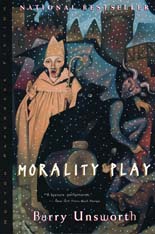
For more than a week in the early days of the semester, my husband would come upon me reading and I would look up from my book and smile broadly. This isn't the usual reaction he sees when I'm reading for school. But this semester, I got to -- had to, really -- read a brilliant work of fiction: Morality Play by Barry Unsworth.
The novel is a mystery of sorts about a traveling troupe of players in the Middle Ages. Our professors assigned it for its historical accuracy in detailing the nuances of everyday life in those times.
I was fascinated by how the players put on their plays with a small ensemble and a ragged array of costumes. They also had symbolic masks and sometimes carried symbolic props. What most drew my attention, though, was the complex set of hand signals the players used to communicate with one another as the play was in progress as well as the common set of mimes and gestures known not only to the players but to their audience as a kind of shorthand to establish character and motivation.
The play we will do, Noah's Flood, was done when the productions were put on by guilds and were more elaborate.
Prof. Lori Ann Ferrell was in class for the first time this week and led our discussion of Unsworth's novel, trying to get us to consider what it told us about medieval times and then trying to get us to consider how we would apply what we had learned to our own production.
At the beginning of class, our director, Melinda Teter, explained that she had cast the play two ways for two different productions. The first would be a standard portrayal of the play, the second would cross genders with men playing the role of women and women playing the role of men. All the roles change in the second production except God. God remains constant.
Nevertheless, I began to wonder if the second play might allow us to think creatively about the nature and essence of God. Is it possible to tell the first story as it is written -- with an angry God deciding to wipe out much of creation and start over -- and tell the second story with a God who is less directly involved? A God who doesn't intervene.
And what does God wear? There has been some talk that a group of dancers on campus might be persuaded to dance in with multi-colored streamers to represent the rainbow. And the flood, too, could have rising waters that dance across the stage. Maybe God is wrapped in the streamers that will become water and the streamers that become rainbow and hands the streamers to the dancers as a way of bringing the flood, as a way of placing the rainbow.

Credit for this photo goes to National Geograpic. To learn more about it go here
And how does an actor play God? So often, good acting involves freeing yourself to become one with your character, letting your character embody you, becoming, if only for a time, this other. Can you do that acting as God? And what about this wrathful Old Testament God, how does an actor with a different theology of God portray that God?
I'll have plenty of time in the next few weeks to consider all of these things because the person Melinda cast as God is me.
My seminary friends and a few in San Diego know that events in my life in the past year have challenged my thoughts on the nature and essence of God -- though I still hold tight to the Gospel message of Jesus and the loving guidance of the Spirit. These friends are taking great pleasure in the fact that, having lost God at times in the past year, I now have to find God within myself.
1 comment:
I can't wait to read and hear more about how you will play God! Sounds like a fun way to earn school credit, too!
I've been trying to meet Melinda, btw, since Annual Conference-- her then pastor, Sharon Rhodes-Wickett (now at Claremont UMC) wanted her to talk with me about the whole young clergy thing!
Post a Comment